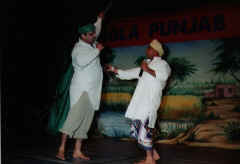Punjab - Literature - Folk Drama
Folk-drama has its roots in the distant past and has been handed down from generation to generation. During Muslim rule when dramatic activities virtually came to a stand-still, the villages were bursting with folk-drama, dancing, mimicry, jugglery, Nautanki and various other forms of fun and frivolity known as Swang, Naqal, Tamasha etc. The artistes who performed them went from village to village beating their drums or step-sticks and collecting audiences. All credit goes to these performers for keeping alive the dramatic tradition of Punjab.
The folk-drama of the Punjab is of two main types like religious and secular. The former is generally musical in form in which events of religious importance like the Ram Lila or the Krishna Lila are presented. The latter comprises mostly Swang, Naqal and Nautanki. Its performances are meant only for entertainment.
Ram Lila
Conscience-keeper of tradition Shri Ram Chander has always been the beau ideal of the Indians who suffered great hazards but established and maintained high principles. Two great epics, Maharishi Balmiki's Ramayan and Tulsi Das Ji's Ram Charitra Manas formed the womb out of which folk drama was born. On the basis of these epics Ramlila was designed as a play. Huge stage is setup and adorned artfully. The life of Lord Rama is depicted through authentically dressed character. Sometimes more than one episode is staged concurrently, like Sita's abduction from Ashok Vatika and the war between Sri Ram & Ravana. The characters impart unity to the action by reciting verses in the fashion of a Greek drama.
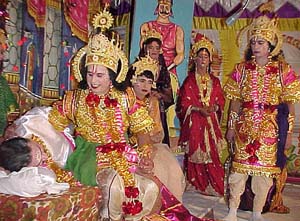
Burning the effigies of Ravan, Meghnath and Kumbhkaran ends the Ram Lila and Sita Ji is rescued with honor signifying victory of good over evil. Ram Lila is played in all cities of Punjab every year with great gusto.
Prahlad Lila
Symbol of God-love, Bhagat Prahlad is venerated by the Punjab's on the occasion of Holi festival. Rasdhris (traditional dancers) dramatize the saga of Bhagat Prahlad's life with great respect. It is done through imitation roles and the interest in action is maintained through songs and music. Bhagat Prahlad, inspite of tortures does not move from his faith in God. In the end truth is shown as the victor over evil.

The legend of King Hiranyakashap is associated with the festival of Holi. This legend signifies the victory of good over evil, of devotion surpassing ambition.
King Hiranyakashap was an ambitious ruler, one who wanted absolute power so that he would be worshipped as God. When this wish was made known, the King's own son, Prahlad, refused to obey his father. Prahlad was an ardent devotee of Lord Vishnu, and it was only to his Lord that he gave allegiance. The proud King was enraged by Prahlad's disobedience and decided to punish him severely.
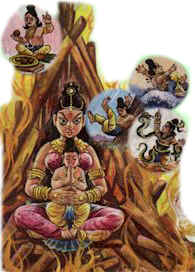
He asked his sister Holika for help. It was believed that Holika was immune to fire and would never be burnt, so the King asked Holika to sit in the centre of a bonfire with Prahlad on her lap, so that the fire could devour him. The bonfire was lit, and young Prahlad sat in Holika's lap, in its centre, praying to Lord Vishnu. His devotion saved him, leaving him untouched by the flames, but Holika was burnt to ashes.
Baba Balak Nath Lila
Baba Balik Nath was a super-being blessed with spiritual powers who is venerated in Jalandhar Doab.
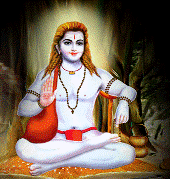
Saga of his life is delineated on the stage through music, song and dance which in dramatic parlance is called Lila and which highlights saintly values.
Guru Balmik Lila
The story of the Guru's life is dramatized in a moving manner.
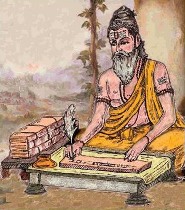
Major events of his life have been versified which are acted through dance, music and song. This Lila is of recent origin and the Rasdharis of Jalandhar Doab are renowned for dramatizing it.
Guru Ravi Das Lila
Rasdharis have made a beautiful endeavor to project the spiritual message of Guru Ravi Das's life.

The Lila depicts the injustices heaped on him, his eternal faith and God-love and the great honor received by him eventually in a spirit of surrender and is put on show in almost every city of Punjab on the Guru's birthday.
Swang
It is a kind of song-drama which is played either in the open or atop of platform. The plot is based on the story of a great personality. In Punjab the Swangs of Puran Nath Jogi, Gopi Nath and Veer Hakikat Rai are very popular. In the first two, the life of detachment and in Kakikat Rai's Swant, the love of religion and spirit of sacrifice for its sake are highlighted and their popularity rests on the fact that they make one conversant with medieval life.
Naqals
Naqal is the art of imitation. The Naqal imitate life in a manner that provokes violent laughter. Naqals entertain as they instruct also. Naqals exhibit their art through crisp conservation. The First : Why ! from where have you come ? The Second : Give me food I am starving. Don't you know that I had gone to meet my daughter and we do not eat anything at our daughter's house.
Bhands
They are the traditional entertainers of Punjab and entertainment is their whole-time profession. They are either invited or just gatecrash during marriages and produce lot of fun and frolic. Their music and dance are typical and they also evoke jokes through dialogue.
